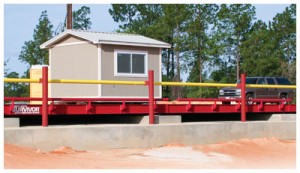The Mine Safety and Health Administration or MSHA (nicknamed “emshaw”) is the government organization that oversees safety at mines, quarries, and related industries. MSHA is headquartered in Arlington, VA, with district offices at six locations around the United States. There are presently over 850 inspectors within MSHA.
 How does MSHA impact scales and the scale industry? Legislation has been on the books since the 1970s relating to berms, guardrails, elevated roadways, bridges, and roads on mine property. These regulations, however, have been very loosely enforced with respect to truck scales. Truck scales have just recently been clearly defined by MSHA as elevated roadways and are therefore now subject to MSHA policies regarding guardrails and berms.
How does MSHA impact scales and the scale industry? Legislation has been on the books since the 1970s relating to berms, guardrails, elevated roadways, bridges, and roads on mine property. These regulations, however, have been very loosely enforced with respect to truck scales. Truck scales have just recently been clearly defined by MSHA as elevated roadways and are therefore now subject to MSHA policies regarding guardrails and berms.
In early 2009 MSHA inspectors initiated an aggressive campaign at these facilities, levying significant fines and penalties related to guardrails on truck scales. Compliance has generally been left to the discretion of the local MSHA inspector. MSHA has been vague in the past as to what was expected from scale owners. The most common criteria provided by MSHA up until this time was that “guardrails were to be half the height of the largest tire on a powered vehicle to cross the scale.” Rice Lake and other scale suppliers have provided higher rails to satisfy the requirement—and this appeared to be acceptable to most MSHA inspectors. This interpretation changed with the release of the MSHA policy letter on August 26, 2010.
The new policy as it relates to truck scales applies specifically to all mining operations and businesses located on mine property, including aggregate facilities, sand and gravel, bulk cement, concrete plants, asphalt operations, strip mines, tipple operations, coal loadouts, and other related businesses. These policies apply to both metal and non-metal mine facilities.
The basic premise of this letter is:
- All elevated scales should be equipped with a curb, rub rail, berm, or guardrail depending on its elevation level. For scales having a driving surface elevated 16 inches or less above the ground, the scale should, at a minimum, be equipped with either a substantial curb or rub rail at least 6 inches high.
- If the height from the driving surface on the scale to the lowest ground surface adjacent to the scale is greater than 16 inches, the drop-off hazard can be mitigated by raising the ground to decrease the distance to less than 16 inches or the scale can be equipped with a guardrail capable of restraining the vehicle from driving off the scale. Any guardrail should extend to at least mid-axle height of the largest motorized vehicle using the scale.
SHA has established that the following four parameters for truck scales must be considered when providing MSHA-compliant guardrails:
- The height of the guardrail (impact height)
- The speed of the vehicle while driving onto, over, or off of the scale
- The loaded weight of the vehicle
- The angle of impact
The clarification provided by MSHA is that the rail must be mid-axle height and capable of keeping an 80,000 pound truck, traveling at 10 to 15 miles per hour, at a 10-degree angle to the direction of traffic on the scale.
Based on the parameters established by MSHA, it is Rice Lake’s position that it is structurally impractical to design a guardrail restraint system for the flat top truck scale designs on the market today. Flat top truck scale products are not designed to handle the lateral forces and conditions as established by MSHA.
The internal structure of the weighbridge on flat top truck scales is designed for compression type loading and not lateral forces of the nature defined by MSHA.
What options are available to scale companies and mine owners?
- The simplest solution is to mitigate the elevation of the scale platform to the 16 inch height as indicated by MSHA. This is often difficult considering state Weights & Measures clearances beneath the bridge even with the lowest of truck scale profiles. In some cases retaining walls or fill material can be located adjacent to the scale platform maintaining the 16 inch elevation.
- One of the best solutions is the Rice Lake SR Side Rail model in either a concrete or steel deck design. The outboard 24WF76# main beams serve as a natural restraint for keeping truck traffic on the scale. By welding an optional 4 inch schedule 40 pipe with standoffs to the top of the beam, the mid-axle rail height can be achieved. Rice Lake has installed a number of these designs at quarries around the country.
- Conventional deep or shallow pits will also provide compliance with the MSHA regulations. Although pits are often the most expensive foundations, in some cases they may provide the best option for the owner.
- Steel highway guardrails are another viable option and can often be purchased and installed by local companies. These rails can be achieved with galvanized railing and I-beam posts and can be bought and installed for as little as $40 per linear foot (prices will vary by geographic location).
Keep in mind that the local MSHA inspector will have the final say on what is acceptable and what is not. As indicated by MSHA, there is no “one-size-fits-all.” The best advice is to consult with the local MSHA inspector to determine the ideal solution for your application. Portions of this article courtesy of Bill Murphy, Rice Lake national heavy capacity director.
